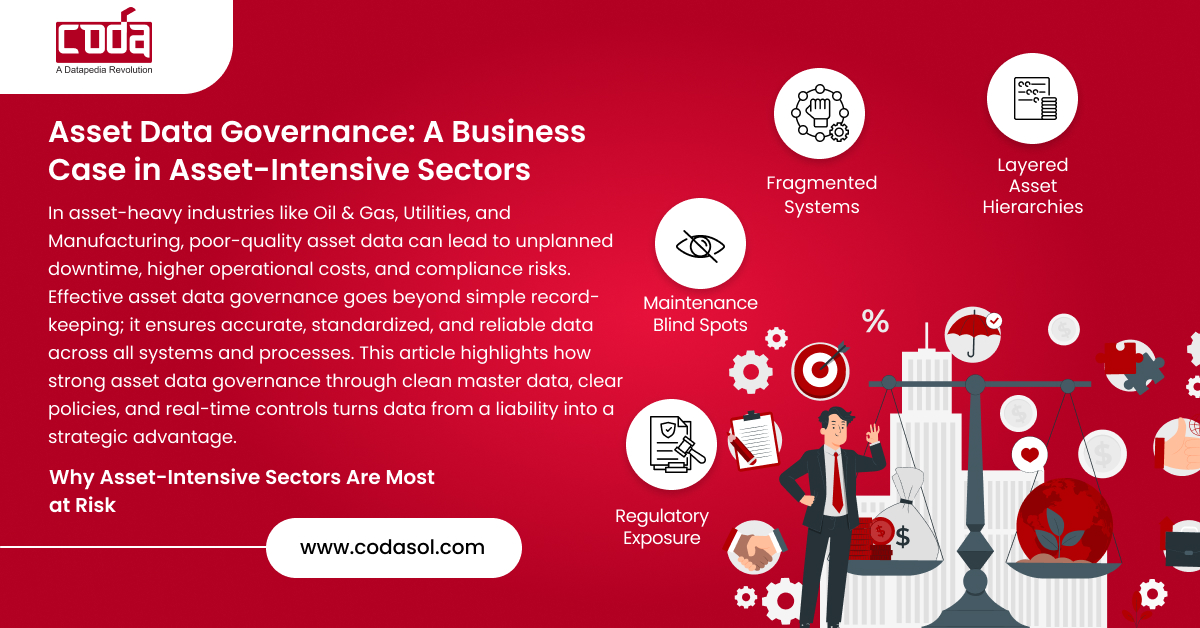Why Every Asset-Intensive Business Needs Asset Data Governance Now
When a turbine sits idle for hours because a wrong spare part was ordered, the real failure isn’t mechanical; it’s data. For organizations in oil & gas, utilities, construction, or manufacturing, poor-quality information is the hidden saboteur that drains uptime, erodes trust, and inflates costs. Asset-data-governance is the safeguard that ensures decisions, systems, and people all work from the same, reliable source of truth.
In asset-heavy industries, downtime is measured not in minutes but in millions. This article explores why governance and data quality must sit at the heart of any digital strategy, and how leaders can transform messy data into a managed asset that drives resilience and growth.
Why Asset-Intensive Sectors Are Most at Risk
The more complex the operation, the more catastrophic the fallout from bad data.
- Layered asset hierarchies: Equipment isn’t a single entry; it’s a network of components, subassemblies, and spare parts. Inconsistent naming or classification disrupts maintenance and procurement.
- Fragmented systems: Many enterprises still juggle ERPs, CMMS platforms, spreadsheets, and siloed local databases. Without governance, the same pump can exist in five formats with conflicting histories.
- Maintenance blind spots: Incorrect calibration data or missing service records trigger delayed shutdowns, over-maintenance, or catastrophic failures.
- Regulatory exposure: In highly regulated environments such as aviation, energy, and healthcare, missing traceability or incomplete audit logs can halt operations and invite penalties.
For leaders managing billions in assets, these are not back-office annoyances; they are boardroom issues that affect safety, compliance, and shareholder confidence.
The Business Case for Asset Data Governance
High-quality data is the difference between firefighting and forward-planning. Governance ensures that quality is sustained, not just patched.
Tangible ROI from Better Data
- Maintenance efficiency: Studies show that technicians waste up to 25–30% of their “wrench time” searching for correct parts or verifying information. Streamlined, governed data turns those wasted hours into productive uptime.
- Inventory optimization: Clean data prevents duplicate stock, enables smarter sourcing, and reduces excess inventory. For a refinery or utility, this can mean millions in freed-up working capital.
- Uptime and reliability: A small error in asset master data can ground entire operations. With governance, uptime improves, unplanned shutdowns drop, and overall asset performance rises.
- Digital readiness: IoT sensors, digital twins, and AI algorithms only work if the underlying data is trustworthy. Without governance, advanced analytics become noise instead of insight.
Here’s a simple view of the impact:
| Benefit Area | Real-World Outcome |
|---|---|
| Maintenance Efficiency | +30% productive wrench time; fewer delays hunting data |
| Procurement & Inventory | Leaner stock levels, reduced duplicate purchases |
| Compliance & Auditability | Complete traceability for regulators and insurers |
| Digital Transformation | Reliable foundation for IoT, AI, and digital twins |
For decision-makers, these aren’t nice-to-have benefits; they directly affect EBITDA and long-term competitiveness.
Why Governance Matters as Much as Quality
Some organizations treat data quality as a one-time “clean-up.” They standardize terms, merge duplicates, and stop there. The problem? Without governance, the chaos creeps back in.
- MDM alone is not enough: Master Data Management (MDM) creates golden records, but governance defines who owns the data, how it’s validated, and when it gets updated.
- Continuous controls: Governance establishes policies, workflows, and real-time validation rules that prevent errors from re-entering the system.
- Clear accountability: With roles like data stewards, custodians, and owners, governance ensures that someone is responsible for accuracy, consistency, and compliance.
Think of quality as cleaning the water in the tank, and governance as installing a filter that keeps the inflow pure. One without the other is wasted effort.
A Practical Framework for Leaders
Here’s what a data governance journey looks like for a typical enterprise. Say, a GCC refinery or a large Indian utility:
- Assessment: Begin with a health check to uncover inconsistencies, duplicates, and critical gaps.
- Standardization: Build taxonomies and hierarchies that are globally consistent but locally adaptable.
- Technology enablement: Deploy an MDM platform with a governance layer for validation, approval workflows, and dashboards.
- Role assignment: Establish data stewards in operations, data owners in strategy, and custodians in IT.
- Continuous monitoring: Use dashboards, audit logs, and reporting to track compliance and flag issues early.
This framework transforms data governance from a compliance exercise into a competitive advantage.
For enterprises running SAP, this process becomes even simpler. Prosol, our AI/ML-powered MDM platform, is available directly in the SAP Store, ensuring seamless integration with existing ERP workflows. This allows organizations to accelerate governance adoption without disrupting core operations.
Case in Point
Consider a manufacturing company operating across India and the Middle East. Before governance, its ERP showed over 40 variations of the same spare part, leading to duplicate procurement worth several million dollars. By implementing asset data governance, complete with standardized taxonomy, steward roles, and automated validation, the company reduced procurement costs by 18% and improved part availability across plants. Governance isn’t an IT upgrade; it’s a profit lever.

Leaders can’t afford to wait until the next unplanned shutdown or failed audit to act. The competitive edge lies in moving now. Want to see how much uptime your business could gain with governed data?
Common Questions About Asset Data Governance
1. What exactly is asset data governance?
It is the framework that combines master data management with policies, rules, and accountability to ensure asset information is always accurate, complete, and compliant.
2. Is this relevant only for big ERP projects?
No. Even without ERP migration, governance ensures that daily operations—from maintenance to procurement—are built on reliable data.
3. How soon can ROI be realized?
Quick wins, such as reduced duplicate procurement or improved part searches, can appear within months. Larger gains, like improved uptime and EBITDA, typically show within 12–18 months.
4. Can governance adapt to multiple regions and compliance requirements?
Yes. A well-structured governance program supports local rules while maintaining global consistency across India, GCC, Far East, and US operations.
5. We already have an MDM tool. Why add governance?
MDM is about structure and quality at a point in time. Governance ensures that quality is sustained, controlled, and auditable over the long term.
Final Word
For asset-intensive enterprises, data errors aren’t just clerical; they’re existential. Poor master data cascades into downtime, wasted capital, and regulatory risk. By embedding governance into the core of operations, leaders create a self-sustaining system where data is no longer a liability but a strategic advantage.
The companies that thrive in the next decade will not simply collect more data; they will govern it.
Don’t let bad data stall your operations. Discover how asset data governance can cut downtime, reduce costs, and unlock reliable performance.


